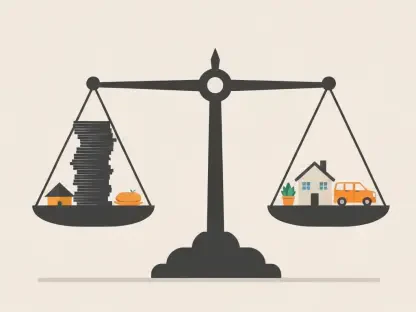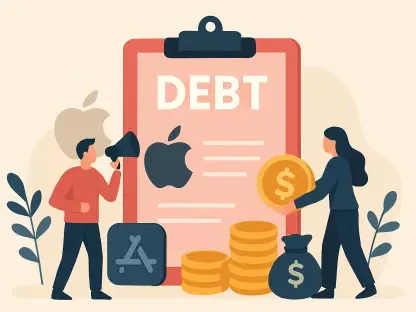The financial world is witnessing a remarkable transformation as cryptocurrencies, once considered a speculative niche, are now finding a foothold in the realm of retirement planning, signaling a shift toward mainstream acceptance. As digital assets gain traction, they are being integrated into tax-advantaged accounts like Individual Retirement Accounts (IRAs) and 401(k)s. This development is not just a trend but a profound change in how investors approach long-term wealth-building, blending the innovation of blockchain technology with the stability of traditional savings vehicles. The growing interest from both individual savers and institutional players highlights a broader recognition of crypto as a legitimate asset class. Brokerages are stepping into this evolving space with new offerings, while regulatory frameworks adapt to accommodate this fusion of old and new finance. This convergence raises intriguing questions about market dynamics, investor behavior, and the future of financial security in a rapidly digitizing economy.
The Emergence of Digital Assets in Savings Plans
Breaking Ground in Traditional Finance
The inclusion of cryptocurrencies in retirement accounts marks a significant departure from their earlier perception as high-risk, speculative investments. This shift reflects a growing confidence among investors who are eager to diversify their portfolios with exposure to the digital economy. By embedding assets like Bitcoin into IRAs and 401(k)s, the financial sector is acknowledging the potential of these instruments for long-term growth and wealth preservation. This is not merely about chasing trends; it represents a fundamental rethinking of what constitutes a balanced retirement strategy. As more individuals seek to hedge against inflation and traditional market fluctuations, the appeal of digital currencies as alternative investments becomes increasingly evident. The momentum behind this integration suggests that cryptocurrencies are no longer on the fringes but are steadily becoming part of the fabric of conventional financial planning, reshaping how future retirees might secure their economic stability.
A Shift in Investor Mindset
Beyond the technical integration, there’s a noticeable change in how investors perceive digital assets within the context of retirement planning. Previously viewed with skepticism, cryptocurrencies are now gaining credibility as tools for diversification, especially among younger generations who are more familiar with blockchain technology. This evolving mindset is driven by a desire for portfolios that can withstand economic uncertainties while capitalizing on emerging sectors. Financial advisors are beginning to field more inquiries about crypto allocations in retirement plans, indicating a broader cultural acceptance. This acceptance is further fueled by the visibility of major cryptocurrencies in mainstream media and their increasing use in everyday transactions. As this perception solidifies, the demand for accessible and secure ways to include digital assets in long-term savings grows, pushing the industry to innovate and adapt to these changing expectations with tailored products and services.
Brokerages Paving the Way for Crypto Access
Innovating Financial Products for Wider Reach
Brokerages are playing a pivotal role in bringing cryptocurrencies into the retirement planning sphere by developing products that cater to both seasoned investors and newcomers. Platforms like Public are at the forefront, offering spot Bitcoin ETFs within IRAs, which simplifies the process of gaining exposure to digital assets without the complexities of direct ownership. This approach lowers the entry barriers for traditional investors who might be wary of navigating crypto exchanges or managing digital wallets. By embedding these offerings into familiar tax-advantaged accounts, brokerages are effectively bridging the gap between conventional finance and the rapidly evolving world of blockchain-based assets. Such innovation not only broadens the investor base but also signals a commitment to meeting the growing demand for diversified retirement options, ensuring that even conservative savers can explore the potential benefits of digital currencies in a structured and regulated environment.
Expanding Opportunities for Retirement Savers
The efforts of brokerages extend beyond mere product offerings; they are actively working to expand the reach of crypto investments to a wider demographic of retirement savers. By integrating digital assets into standard brokerage accounts alongside IRAs, these firms are creating a seamless experience that appeals to individuals at various stages of their financial journey. This strategic move taps into the vast pool of retirement savings, a market segment previously inaccessible to crypto investments due to regulatory and structural constraints. The focus is on accessibility and education, ensuring that investors understand the risks and rewards associated with such allocations. This expansion is crucial for democratizing access to the digital economy, allowing even those with a cautious approach to participate in what could be a transformative asset class. As brokerages refine their offerings, they are setting the stage for a more inclusive financial landscape where retirement planning embraces cutting-edge opportunities.
Regulatory Frameworks Shaping the Landscape
Policy Developments as a Driving Force
Significant regulatory advancements are facilitating the integration of cryptocurrencies into retirement accounts, creating a more supportive environment for financial institutions. A notable milestone is Executive Order 14330, signed on August 7, 2025, titled “Democratizing Access to Alternative Assets for 401(k) Investors.” This directive instructs federal agencies to provide clearer guidelines on incorporating alternative assets into retirement plans, reducing ambiguity for brokerages and investors alike. Such policy support acts as a catalyst, encouraging traditional finance to embrace digital currencies with greater confidence. By addressing long-standing barriers, these regulations are helping to legitimize crypto as a component of long-term savings strategies. The impact of this executive action is already evident in the increasing number of firms exploring crypto offerings, highlighting how governmental backing can accelerate the adoption of innovative financial tools in a historically conservative space.
Addressing Lingering Challenges
Despite these positive steps, the regulatory landscape is not without its complexities, as certain aspects of crypto integration in retirement accounts remain unresolved. Issues such as the treatment of staking rewards and income from decentralized finance (DeFi) within IRAs are still under discussion, with clearer guidelines expected by 2027. This uncertainty poses challenges for both investors and financial institutions seeking to navigate compliance while innovating. Regulators are tasked with striking a balance between fostering technological advancement and safeguarding investor interests, a delicate act that requires careful consideration of market dynamics. The ongoing dialogue between policymakers and industry stakeholders is essential for crafting rules that mitigate risks like fraud or excessive volatility without stifling growth. As these frameworks evolve, they will play a critical role in determining the pace at which digital assets become a normalized part of retirement planning, ensuring that innovation aligns with stability.
Market Dynamics and Community Reactions
Enhancing Liquidity and Institutional Engagement
The incorporation of cryptocurrencies into retirement accounts is set to have a profound effect on market dynamics, particularly in terms of liquidity and institutional involvement. With products like Bitcoin ETFs becoming available in IRAs, a new stream of capital from retirement funds is expected to flow into the crypto market, enhancing trading volumes and market depth. Although immediate price surges are unlikely, this steady influx could exert gradual upward pressure on valuations, contributing to the overall maturation of the sector. Institutional interest is also on the rise, as the legitimacy conferred by retirement account integration attracts larger players seeking stable entry points into digital assets. This trend suggests a future where cryptocurrencies are less volatile due to broader participation, creating a more resilient market structure that can withstand economic fluctuations while offering retirement savers a viable diversification option.
Reflecting Community Optimism and Caution
Reactions within the crypto community to this development are largely positive, with many seeing it as a long-awaited validation of digital currencies as credible long-term investments. Social media platforms are abuzz with conversations about the benefits of tax-advantaged crypto investing, with enthusiasts and thought leaders alike emphasizing the potential of assets like Bitcoin to serve as inflation hedges. However, this optimism is tempered by a recognition of persistent risks, including market volatility and the need for robust investor education. Community discussions often highlight the importance of understanding the nuances of digital assets before allocating retirement funds, reflecting a maturing perspective that balances excitement with pragmatism. This duality in sentiment underscores the broader journey of cryptocurrencies toward mainstream acceptance, where enthusiasm for innovation coexists with a call for informed decision-making to protect long-term financial security.
Looking Ahead to a Transformed Financial Future
Near-Term Expansion of Asset Offerings
As the integration of cryptocurrencies into retirement plans gains momentum, the short-term outlook points to an expansion in the variety of digital assets available within these accounts. Beyond Bitcoin ETFs, other prominent cryptocurrencies and possibly even tokenized assets could soon be included in IRA and 401(k) offerings, providing investors with greater choice and flexibility. This diversification within retirement portfolios reflects the growing sophistication of the crypto market and the willingness of brokerages to experiment with innovative products. Regulatory clarity expected in the coming years will likely accelerate this trend, enabling financial institutions to roll out new options with confidence. Such developments promise to further normalize digital assets in the eyes of traditional investors, paving the way for a more dynamic retirement planning landscape where savers can tailor their allocations to match their risk tolerance and financial goals.
Long-Term Capital Inflows and Market Stability
Over a longer horizon, the potential impact of retirement accounts on the crypto market becomes even more transformative, with analysts projecting substantial capital inflows from the multi-trillion-dollar retirement sector. Even a modest allocation of these funds to digital assets could channel hundreds of billions of dollars into the space, significantly boosting market capitalization. This influx is anticipated to enhance stability by reducing the volatility that has historically characterized cryptocurrencies, as the broader investor base and consistent capital flow create a buffer against sharp price swings. The normalization of digital assets as standard components of diversified portfolios, akin to stocks or bonds, appears increasingly likely. This shift could redefine financial planning for future generations, embedding cryptocurrencies as a cornerstone of retirement security while reshaping the broader economic ecosystem with unprecedented levels of digital integration.









